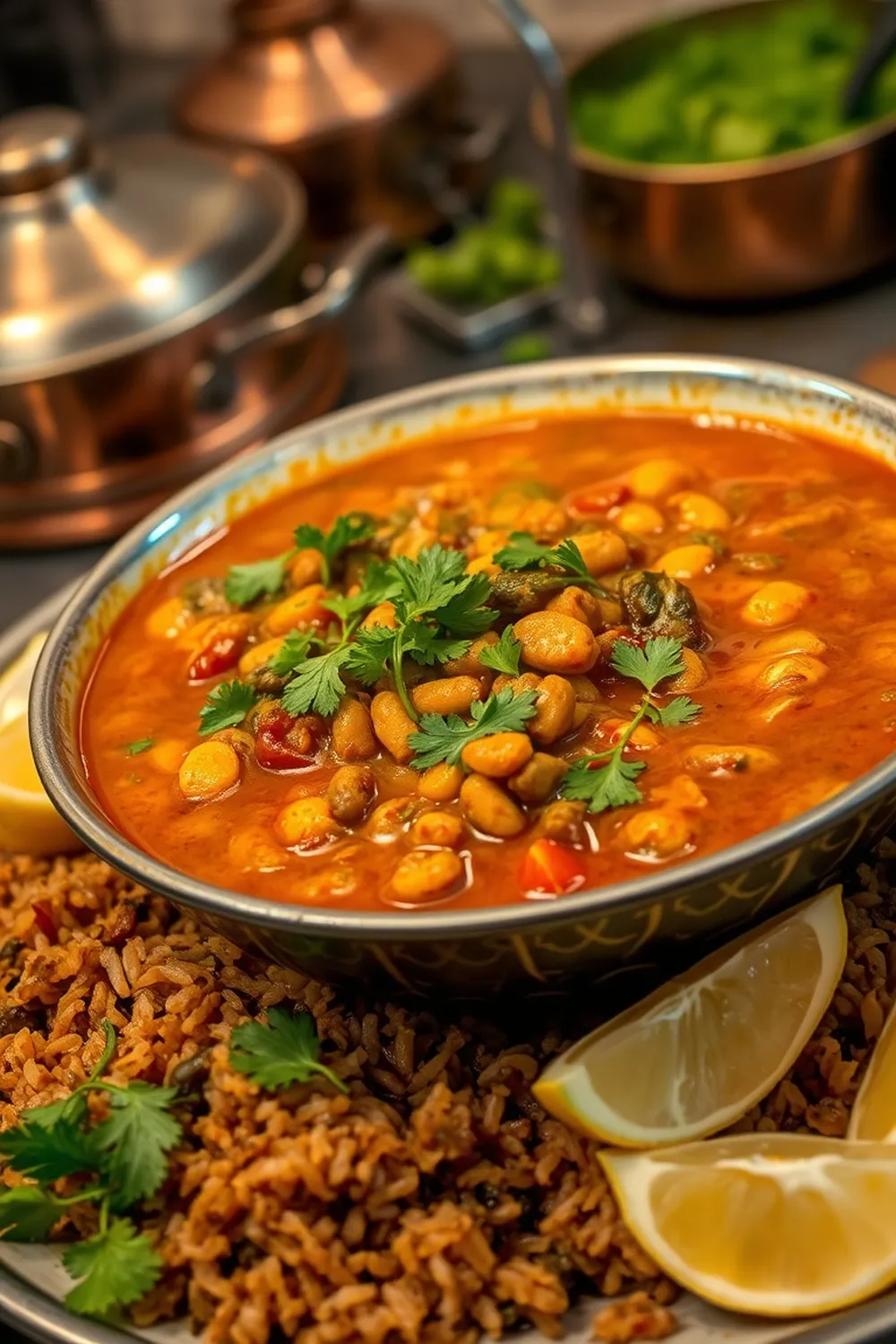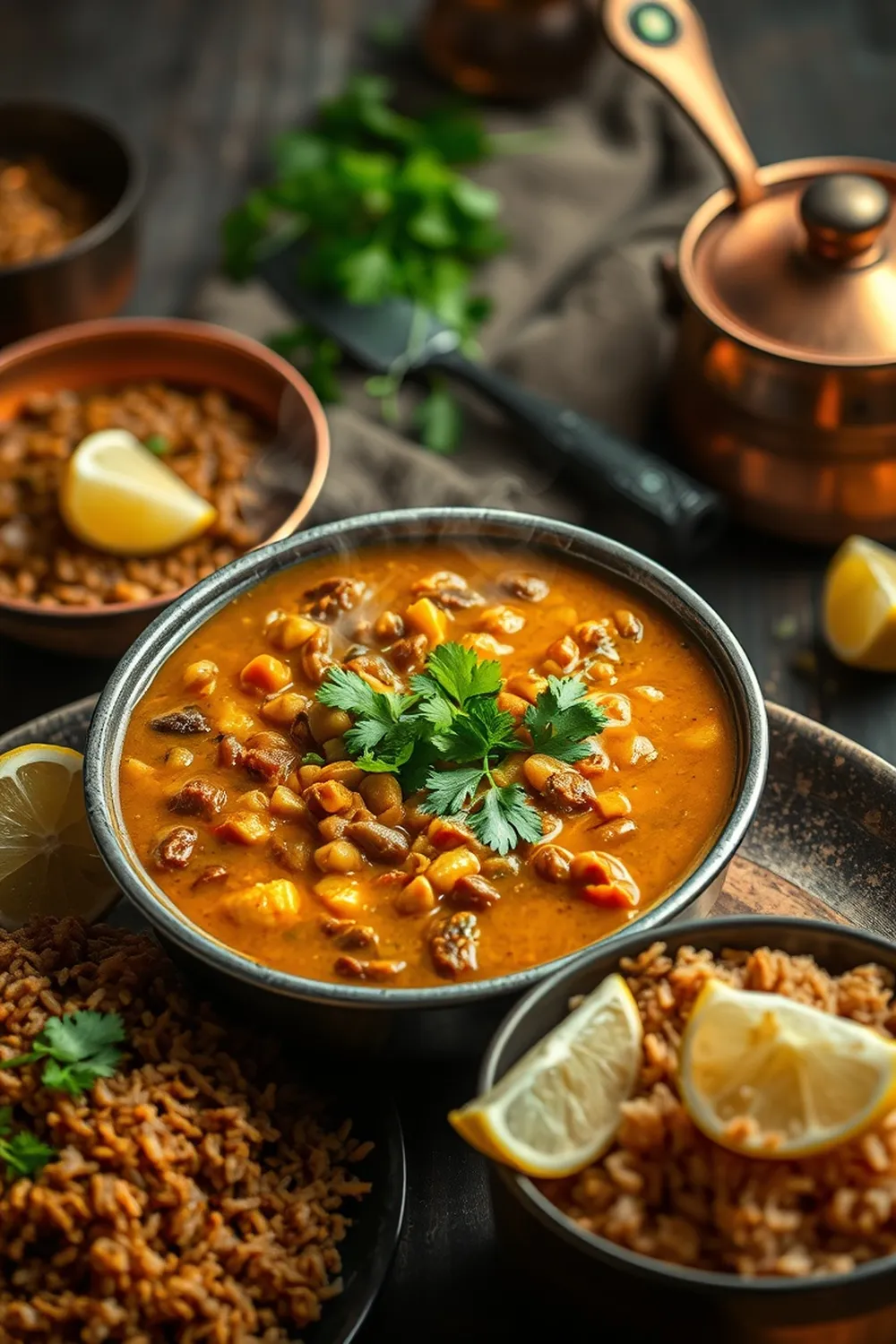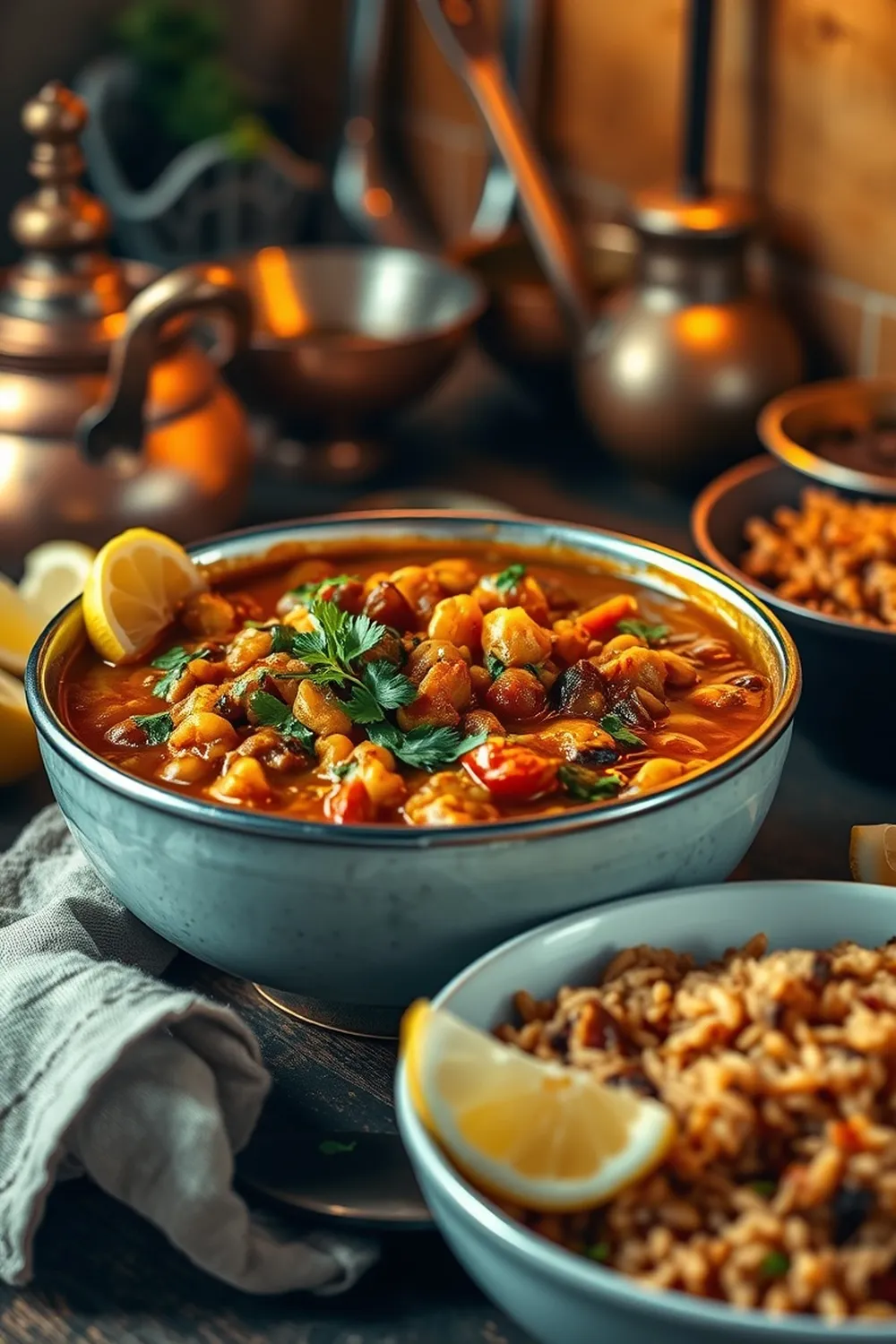- Pressure cook lentils, vegetables (potatoes, bottle gourd, eggplant, pumpkin, tomatoes), fenugreek leaves, and water for 5-6 whistles until soft.
- Mash or blend the cooked mixture until smooth. Strain if desired for a smoother consistency.
- Grind garlic, ginger, green chilies, coriander seeds, cinnamon, cloves, cumin, and red chili powder into a masala paste.
- Sauté chopped onions in ghee until golden brown. Add the masala paste and cook until fragrant.
- Combine the mashed lentil-vegetable mixture with the sautéed masala. Simmer for 5-7 minutes.
- Stir in tamarind pulp and simmer for 2-3 minutes to balance the flavors.
- Serve hot with Parsi brown rice, lemon wedges, and kachumber salad.
- Calories:350 kcal25%
- Energy:1464 kJ22%
- Protein:18 g28%
- Carbohydrates:50 mg40%
- Sugar:8 mg8%
- Salt:400 g25%
- Fat:15 g20%
Last Updated on 6 months ago by Neha Deshmukh
Parsi Dal Recipe: Lentils & Vegetable Curry with Kasuri Methi
Hey everyone! Today, I’m sharing a recipe that’s incredibly close to my heart – Parsi Dal. It’s a comforting, flavorful lentil and vegetable curry that’s a staple in Parsi cuisine. I first made this when I was trying to recreate my aaji’s (grandmother’s) cooking, and honestly, it took a few tries to get it just right! But trust me, the effort is so worth it. This dal is a hug in a bowl, perfect with a steaming plate of Parsi brown rice.
Why You’ll Love This Recipe
This Parsi Dal isn’t just delicious; it’s a beautiful blend of flavors and textures. The combination of lentils and vegetables creates a hearty, satisfying meal. The fragrant spices and the unique touch of kasuri methi (dried fenugreek leaves) elevate it to something truly special. Plus, it’s a fantastic way to get a good dose of protein and veggies!
Ingredients
Here’s what you’ll need to make this amazing Parsi Dal:
- 1 cup pigeon pea lentils (tuvar dal)
- 0.25 cup green gram lentils (moong dal)
- 0.25 cup pink lentils (masoor dal)
- 2 medium potatoes, chopped (about 300g)
- 1 cup bottle gourd (opo squash), chopped (about 150g)
- 2-3 medium eggplants, chopped (about 400g)
- 1 cup pumpkin, chopped (about 200g)
- 4-5 medium tomatoes, chopped (about 400g)
- 1 tablespoon dried fenugreek leaves (kasuri methi)
- 12 garlic cloves
- 1 inch ginger, chopped
- 2 green chilies
- 1 tablespoon coriander seeds
- 2 inches cinnamon stick
- 8-9 cloves
- 0.5 teaspoon cumin seeds
- 0.5 tablespoon red chili powder
- 2-3 tablespoons ghee
- 1 medium onion, chopped (about 150g)
- 3-4 teaspoons tamarind pulp
- 4 cups water (1 litre)
Ingredient Notes
Let’s talk about a few key ingredients that make this Parsi Dal so authentic:
- Tuvar Dal, Moong Dal & Masoor Dal: The combination of these three lentils is traditional. Tuvar dal gives it body, moong dal adds a subtle sweetness, and masoor dal helps create a creamy texture.
- Kasuri Methi: This is a must! It has a unique, slightly bitter flavor that’s essential to Parsi cuisine. You can find it at most Indian grocery stores. Don’t skip it – it really makes the dish!
- Ghee: While you can use oil, ghee adds a richness and flavor that’s characteristic of Parsi cooking. My aaji always said ghee is the secret to a good dal!
- Vegetables: Feel free to adjust the vegetables based on what you have on hand. Traditionally, bottle gourd and pumpkin are used, but you can add carrots or even green beans.
Step-By-Step Instructions
Alright, let’s get cooking!
- First, combine the tuvar dal, moong dal, masoor dal, potatoes, bottle gourd, eggplant, pumpkin, tomatoes, and water in a pressure cooker.
- Cook for 5-6 minutes, or until the lentils and vegetables are soft. Let the pressure release naturally.
- Once cooled, mash or blend the cooked mixture until smooth. If you prefer a smoother consistency, strain it through a sieve.
- Now, let’s make the masala! Grind the garlic, ginger, green chilies, coriander seeds, cinnamon, cloves, cumin, and red chili powder into a fine paste. A little water helps with grinding.
- In a separate pan, melt the ghee over medium heat. Add the chopped onion and sauté until golden brown.
- Add the masala paste to the ghee and cook for a few minutes until fragrant. You’ll know it’s ready when the oil starts to separate.
- Pour in the mashed lentil-vegetable mixture and stir well to combine. Simmer for 5-7 minutes, allowing the flavors to meld.
- Finally, stir in the tamarind pulp and simmer for another 2-3 minutes. This balances the flavors beautifully.
- Sprinkle in the kasuri methi and give it a final stir.
Expert Tips
- Don’t overcook the lentils! You want them soft, but not mushy.
- Adjust the amount of green chilies and red chili powder to your spice preference.
- If you don’t have a pressure cooker, you can cook the lentils and vegetables in a pot on the stovetop. It will take longer, about 45-60 minutes.
Variations
- Vegan Adaptation: Simply substitute the ghee with your favorite cooking oil, like vegetable or coconut oil.
- Gluten-Free: This recipe is naturally gluten-free!
- Spice Level Adjustment: Reduce or omit the green chilies and red chili powder for a milder flavor. Add a pinch of cayenne pepper for extra heat.
- Festival Adaptations (Navroz): For Navroz, some families add a touch of jaggery (gur) to the dal for a slightly sweet and savory flavor.
Serving Suggestions
Parsi Dal is traditionally served hot with Parsi brown rice, a wedge of lemon, and kachumber salad (a refreshing cucumber, tomato, and onion salad). It’s also delicious with roti or naan. A dollop of yogurt on the side is a lovely addition too!
Storage Instructions
Leftover Parsi Dal can be stored in an airtight container in the refrigerator for up to 3 days. It also freezes well for up to 2 months. Reheat gently on the stovetop or in the microwave.
FAQs
1. What type of lentils are traditionally used in Parsi Dal?
Traditionally, a combination of tuvar dal (pigeon pea lentils), moong dal (green gram lentils), and masoor dal (pink lentils) is used.
2. Can I make this dal ahead of time?
Yes, absolutely! In fact, the flavors develop even more overnight.
3. What is Kasuri Methi and where can I find it?
Kasuri methi is dried fenugreek leaves. You can find it at most Indian grocery stores, or online.
4. How can I adjust the spice level of this dal?
Reduce or omit the green chilies and red chili powder for a milder flavor.
5. What is the best way to serve Parsi Dal for a special occasion?
Serve it with Parsi brown rice, a refreshing kachumber salad, and a wedge of lemon. A dollop of yogurt adds a nice touch.
6. Can I use a different type of oil instead of ghee?
Yes, you can use vegetable oil or coconut oil, but ghee adds a unique richness and flavor that’s traditional to Parsi cooking.
Enjoy this little piece of my heritage! I hope you love making and eating this Parsi Dal as much as my family and I do. Let me know in the comments how it turns out for you!










